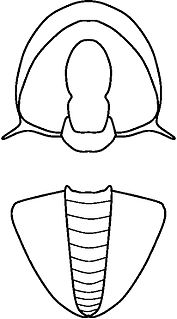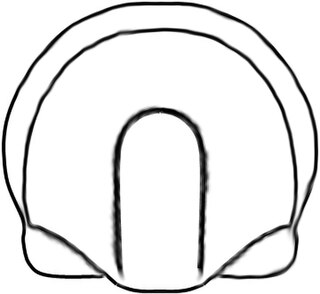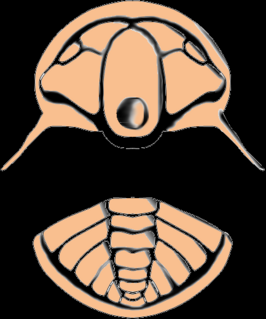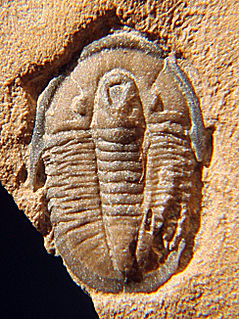Related Research Articles

Acidiscus Rasetti, 1966, is a genus of Eodiscinid trilobite belonging to the family Weymouthiidae Kobayashi T. (1943), Order Agnostida Salter (1864). It lived during the Botomian stage = late Lower Cambrian Stage 4 ; the upper Botomian boundary corresponds to base of the Middle Cambrian, Miaolingian Series and Wuliuan stage.

Analox Rasetti, 1966 is a genus of Eodiscinid trilobites belonging to the family Weymouthiidae Kobayashi T. (1943), Order Agnostida It lived during the Botomian stage. It can easily be distinguished from other trilobites by the two furrows that extend forwards and sidewards from the front of the glabella.
Parapagetia is an extinct genus from a well-known class of fossil marine arthropods, the trilobites. It lived during the Botomian stage, which lasted from approximately 524 to 518.5 million years ago. This faunal stage was part of the Cambrian Period.

Dicerodiscus is an extinct genus from a well-known class of fossil marine arthropods, the trilobites. It lived during the early part of the Botomian stage, in China. Four species have been assigned to it. Dicerodiscus is unique for an eodiscoid in having conspicuous and curved spines that are attached anteriorly, and at their base are directed outward perpendicular to the midline, before gradually bending further backwards.
Resserops is an extinct genus from a well-known class of fossil marine arthropods, the trilobites. It lived during the middle of the Atdabanian or the early part of the Botomian stage, which lasted from approximately 524 to 518.5 million years ago. This faunal stage was part of the Cambrian Period. It has been found in Spain and southern Morocco. It can be recognised by the sabre-like spines of the headshield that are a smooth continuation of the frontal edge, and the enlarged spines on the 9th segment of the thorax.
Cirquella is an extinct genus from a well-known class of fossil marine arthropods, the trilobites. It lived during the Atdabanian stage, in the former continent Laurentia.

Tsunyidiscus is a trilobite belonging to the Suborder Eodiscina. Tsunyidiscus appeared near the end of the Lower Cambrian, during the late Atdabanian stage of geologic time and some collections suggest it may have survived into the Botomian. The genus is very small, oculate and isopypous with a narrow dome-shaped glabella and a narrow bullet-shaped pygidial axis. Thorax consists of three segments. Tsunyidiscus is the only genus currently attributed to the family Tsunyidiscidae.
Acmarhachis is a genus of trilobite in the order Agnostida, which lived in what are now Australia, Canada, China (Anhui), Kazakhstan, Russia (Kharaulakh), and the US. It was described by Resser in 1938, and the type species is Acmarhachis typicalis.
Mesolenellus is an extinct genus of trilobites that lived during the lower Cambrian (Botomian), found in Greenland and Spitsbergen.

Conocoryphe is a genus of primarily eyeless trilobites belonging to the family Conocoryphidae. They lived during the Middle Cambrian period, about 505 million years ago. These arthropods lived on the sea bottom (epifaunal) and lived off dead particulate organic matter.

Richterops is an extinct genus of trilobite arthropods. The genus lived during the middle of the Atdabanian or the early part of the Botomian stage, which lasted from approximately 524 to 518.5 million years ago. This faunal stage was part of the second half of the Lower Cambrian. It has been found in southern Morocco. It can be recognised by the long spines of the headshield that are a smooth continuation of the frontal edge, and the enlarged spines on the 11th segment of the thorax.

Eodiscina is trilobite suborder. The Eodiscina first developed near the end of the Lower Cambrian period and became extinct at the end of the Middle Cambrian. Species are tiny to small, and have a thorax of two or three segments. Eodiscina includes six families classified under one superfamily, Eodiscoidea.

Mallagnostus Howell, 1935, is a trilobite genus belonging to the family Weymouthiidae Kobayashi T. (1943), Order Agnostida Salter (1864) according to Whittington et al. 1997. It lived during the late Lower Cambrian, with remains found in USA, Canada (Newfoundland), Spain, England, Russia, Mongolia, and the early Middle Cambrian as reported from China and Russia (Yakutia).

Tchernyshevioides is a diminutive trilobite that lived during the early Middle Cambrian (Amgaian) and has been found in the Russian Federation and the Jbel Wawrmast Formation of Morocco.

The Weymouthiidae Kobayashi 1943 are an extinct family of eodiscinid agnostid trilobites. They lived during the late Lower Cambrian and earliest Middle Cambrian in the so-called Olenellus- and Eokochaspis-zones in the former paleocontinents of Laurentia, Avalonia, Gondwana. The Weymouthiidae are all blind and lack free cheeks.

Eodiscidae is a family of agnostid trilobites that lived during the final Lower Cambrian and the Middle Cambrian. They are small or very small, and have a thorax of two or three segments. Eodiscidae includes nine genera.
The Hebediscidae Kobayashi, 1944, are a family of trilobites belonging to the order Agnostida that lived during the Lower Cambrian. They are small or very small, and have a thorax of two or three segments. The Hebediscidae include five genera.
The Calodiscidae Kobayashi, 1943 [nom. transl. Öpik, 1975 ex Calodiscinae Kobayashi, 1943] are a family of trilobites belonging to the order Agnostida that lived during the Lower Cambrian. They are small or very small, and have a thorax of two or three segments. The Calodiscidae includes five genera.

Cedaria is a small, rather flat trilobite with an oval outline, a headshield and tailshield of approximately the same size, 7 articulating segments in the middle part of the body and spines at the back edges of the headshield that reach halflength of the body. Cedaria lived during the early part of the Upper Cambrian (Dresbachian), and is especially abundant in the Weeks Formation.

The Paradoxidoidea Hawle & Corda 1847, are a superfamily of trilobites, a group of extinct marine arthropods. They occurred during the late Lower Cambrian (Toyonian) and disappeared at the end of the Middle Cambrian.
References
- ↑ S. M. GON III. "Order Agnostida" . Retrieved December 3, 2010.
- ↑ MIKKO HAARAMO (March 11, 2008). "†Yukoniidae". Mikko's Phylogeny Archive. Retrieved December 3, 2010.
- ↑ PALMER, A. R. 1968, Cambrian trilobites of east-central Alaska. Prof. Pap. U. S. Geol. Surv., 559-B pp. B1-B115, pls. 1-15.
- ↑ JELL, P.A. (1975). "Australian Middle Cambrian Eodiscoids with a review of the superfamily". Palaeontographica Abteilung A. 150: 1–97. cited in H.B. WHITTINGTON; et al., eds. (1997). Part O, Treatise on Invertebrate Paleontology. Revised, Volume 1 – Trilobita – Introduction, Order Agnostida, Order Redlichiida.
- ↑ WHITTINGTON, H.B.; et al. (1997). Introduction, Order Agnostida, Order Redlichiida. Treatise on Invertebrate Paleontology. Part O.Revised, Volume 1 – Trilobita. Boulder, Colorado/Lawrence, Kansas: Geological Society of America/University of Kansas Press. pp. 398–400. ISBN 0-8137-3108-9.